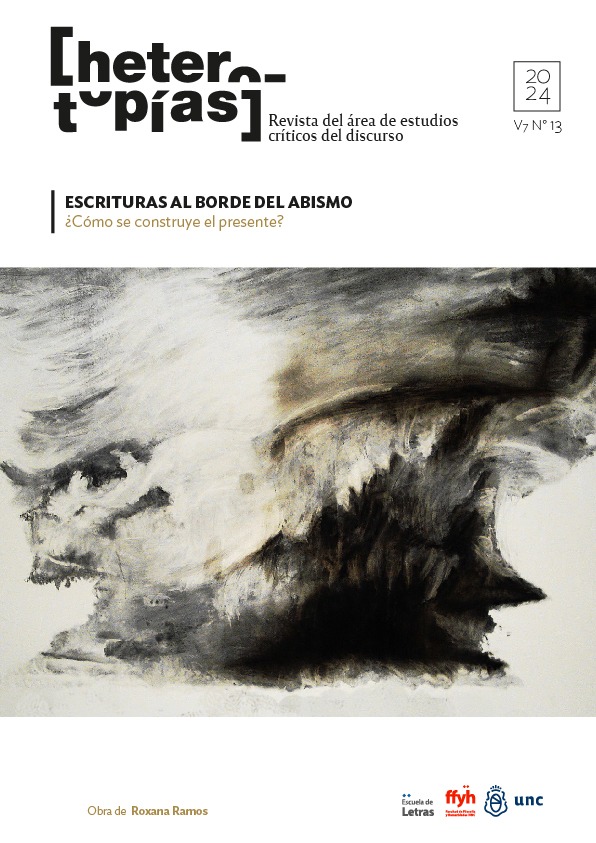Exoticism and Otherness in Argentine Cinema: Copacabana (Martín Rejtman, 2006) and Lluvia de jaulas (César González, 2019)
Main Article Content
Abstract
The article addresses the notion of exoticism proposed by Victor Segalen to explore its power to think about some recent Argentine audiovisual productions. The analysis of the particularities of his study of the figure of the exot and his assessment of diversity constitute the basis for evaluating how the circulation of documentary films that construct an exotic point of view on otherness can dismantle certain conventional ways of approaching territories of the Otherness. Copacabana (Martín Rejtman, 2006) and Lluvia de jaulas (César González, 2019) propose exotic journeys through social universes that are strange to their filmmakers: Bolivian immigration in one case and the bourgeois city in the other. The appeal to distanced perceptual devices or the resource to the figure of wandering constitute two different modalities of appearance of exoticism, becoming a privileged disruptive strategy to dismantle the pre-eminence of sameness and propose other conceptions of otherness.
Downloads
Article Details

This work is licensed under a Creative Commons Attribution-NonCommercial-ShareAlike 4.0 International License.
Those authors who have publications with this journal, accept the following terms: Those authors who have publications with this journal, accept the following terms:
a. The authors will keep their copyright and guarantee to the journal the right of first publication of their work, which will be simultaneously subject to the Creative Commons Attribution - Non-Commercial - Share Alike (by-nc-sa) Attribution License; no commercial use of the original work or any derivative works is allowed, the distribution of which must be done with a license equal to the one that regulates the original work.
b. Authors may adopt other non-exclusive license agreements for the distribution of the published version of the work (e.g., deposit it in an institutional telematic archive or publish it in a monographic volume) provided that the initial publication in this journal is indicated.
c. Authors are allowed and recommended to disseminate their work through the Internet (e.g. in institutional telematic archives or on their website) before and during the submission process, which may lead to interesting exchanges and increase the number of citations of the published work. (See The effect of open access).
How to Cite
References
Allouche, C. (enero-junio, 2021). Où commence la périphérie ? Horizon commun des cinématographies argentine et brésilienne contemporaines. RITA, 14, Recuperado de: http://www.revue-rita.com/articles/ou-commence-la-peripherie-horizon commun descinematographies-argentine-et-bresilienne-contemporaines-claire-allouche.html
Bernini, E. (2015). ¿Qué puede un lumpen? Gracia, justicias y heterogeneidad. Kilómetro 111, 15, pp. 23-36.
Bourriaud, N. (2009). Radicante. Buenos Aires: Adriana Hidalgo.
Caggiano, S. (2012). El sentido común visual. Disputas en torno a género, “raza” y clase en imágenes de circulación pública. Buenos Aires: Miño y Dávila.
Depetris Chauvin, I. (2014). Bolivians in Argentina. The Other Fiesta. ReVista. Harvard Review of Latin America, vol. XIII.
González, C. (2021). El fetichismo de la marginalidad. Buenos Aires: Sudestada.
Grimson, A. (1997). Relatos de la diferencia y la igualdad. Los bolivianos en Buenos Aires. Nueva Sociedad, 147, pp. 96-107.
Iglesias Santos, M. (2010). Imágenes del otro. Identidad e inmigración en la literatura y el cine. Madrid: Biblioteca nueva.
Ludmer, J. (2010). Aquí América Latina. Una especulación. Buenos Aires: Eterna Cadencia.
Mezzadra, S. y Neilson, B. (2016). La frontera como método. O la multiplicación del trabajo. Buenos Aires: Tinta limón.
Oubiña, D. (2013). Las huellas del pié: riesgos y desafíos del cine argentino contemporáneo. En Andermann, J. y Fernández Bravo, A. (Comps.). La escena y la pantalla. Cine contemporáneo y el retorno de lo real (pp. 41-50). Buenos Aires: Colihue.
Oubiña, D. y Filipelli, R. (2007). Los pobres: maneras de ejercer un oficio. Punto de vista, 88, pp. 35-36.
Rancière, J. (1991). Breves viajes al país del pueblo. Buenos Aires: Nueva Visión.
Sarlo, B. (2009). La ciudad vista. Mercancías y cultura urbana. Buenos Aires: Siglo Veintiuno.
Segalen, V. (2017). Ensayo sobre el exotismo. Una estética de lo diverso. Madrid: La línea del horizonte.
